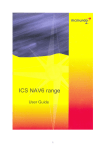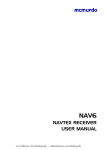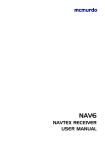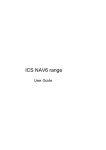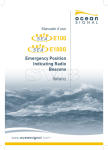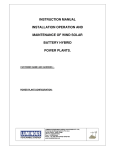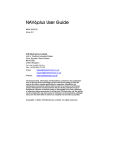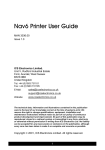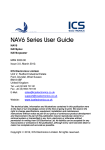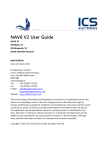Download mcmurdo NAV-7 Specifications
Transcript
29570 mcmurdo cat 31/1/07 12:54 Page 1 EMERGENCY LOCATION BEACONS McMurdo Silver Point Airport Service Road Portsmouth PO3 5PB United Kingdom Tel: +44 (0) 23 9262 3900 Fax: +44 (0) 23 9262 3998 E-mail: [email protected] www.mcmurdo.co.uk Distributors and agents throughout the world Dealer: EMERGENCY LOCATION BEACONS 29570 mcmurdo cat 31/1/07 12:54 Page 3 The Company Established in 1937, McMurdo leads the way in the development and manufacture of emergency location beacons and NAVTEX technology. Based in Portsmouth England, McMurdo first produced a COSPAS-SARSAT approved EPIRB in July 1989. McMurdo further galvanised its position as the leader in safety equipment technology in 1992 with the release of the first GMDSS approved Search And Rescue Transponder (SART). Since that date we have continually led the way in the functionality and accuracy of emergency location beacons launching a PLB (Personal Locator Beacon) for use on land, sea or air in 2000. Also in that year GPS technology was introduced to both the EPIRB and the PLB. NAVTEX technology is another area where McMurdo has considerable expertise, developing and manufacturing NAVTEX receivers for both SOLAS and non-SOLAS vessels. The McMurdo name stands for high quality products using the latest technology. Organisations such as the Royal Navy and the US Coastguard understand the importance of ultra-reliable high quality equipment which is why they have chosen McMurdo products for their vessels and their crew. McMurdo products are used around the world, on land, sea and in the air, where safety is important you will find McMurdo. 2 www.mcmurdo.co.uk Service and Spares McMurdo has a complete customer services operation that handles the repair and servicing of our full range of products. From scheduled beacon battery changes to the service and repair of Navtex and VHF equipment our team is here to help. Our in-house service department operates in support of our worldwide service agents who are fully trained and certified to service and repair McMurdo equipment. For your nearest service agent please visit www.mcmurdo.co.uk. Contents Glossary How does an EPIRB work? EPIRBs (Smartfind) Personal Locator Beacons (Fastfind) SART (Search And Rescue Transponder) S-VDR Float Free Capsule Accessories Handheld VHF Radios What is NAVTEX Professional NAVTEX Leisure NAVTEX Technical Specifications 4 6 8 10 12 13 14 16 18 20 21 24 3 29570 mcmurdo cat 31/1/07 12:54 Page 5 Glossary Automatic Activation An EPIRB that is activated when it comes in contact with water Manual Activation An EPIRB that is activated by the user Automatic Deployment An EPIRB that is automatically released from its housing when the integral HRU is submerged. Manual Deployment An EPIRB that is release from its bracket by hand. McMurdo EPIRBs are available with either a manual “Carrysafe” bracket or an Auto Housing. Category 1 EPIRB An EPIRB that is automatically deployed and activated when in contact with water. The EPIRB may also be manually deployed and activated. Category 2 EPIRB A manually deployed EPIRB. Once removed from its bracket this EPIRB will be automatically activated when in contact with water or can be manually activated. Class 1 EPIRB or PLB Rated to operate down to –40 degrees Celsius Class 2 EPIRB or PLB Rated to operate down to –20 degrees Celsius COSPAS-SARSAT International satellite system for search and rescue. A joint operation between France, Canada, Russia and the USA who monitor the 406 MHz satellite system. ELT Emergency Locator Transmitter. Aviation equivalent of an EPIRB EPIRB Emergency Position Indicating Radio Beacon. FAA Federal Aviation Administration (USA) FCC Federal Communications Commission (USA) GEOSAR Geostationary Search And Rescue system. Part of the COSPAS-SARSAT satellite system GMDSS Global Maritime Distress and Safety System HRU Hydrostatic Release Unit. A release mechanism activated by water pressure. MCC Mission Control Centre. The MCC manages satellite information from the LUT and sends an alert to the Rescue Coordination Centre for the region. MED Marine Equipment Directive. European certification for equipment that meets the standards required by the IMO and SOLAS. MOB Man Overboard NAVTEX A system used for the automatic reception of localised maritime safety and weather information. NOAA National Oceanic and Atmospheric Administration.(USA) PLB Personal Locator Beacon RDF Radio Direction Finder RNLI Royal National Lifeboat Institute SAR Search And Rescue SOLAS Safety Of Life At Sea. Minimum standards of safety set out by the International Maritime Organisation S-VDR Simplified Voyage Data Recorder. UIN Unique Identifier Number programmed into an EPIRB or PLB IMO International Maritime Organisation USCG United States Coast Guard LEOSAR Low-altitude Earth Orbiting Search And Rescue system. Wheelmark Awarded to products that conform to International Maritime Organisation (IMO) type approval LUT Local User Terminal. A ground receiving station that picks up the initial EPIRB signal and relays it to the Mission Control Centre. The LUT also calculates the position the signal was transmitted from. 4 MCA Maritime and Coastguard Agency (UK) www.mcmurdo.co.uk 5 29570 mcmurdo cat 31/1/07 12:54 Page 7 How does an EPIRB work? An Emergency Position Indicating Radio Beacon (EPIRB) or Personal Locator Beacon (PLB) is used to alert search and rescue services in the event of an emergency. They do this by transmitting a coded message on the 406 MHz distress frequency. This message is relayed via satellite and earth station to the nearest rescue co-ordination centre. 406 MHz EPIRBs and PLBs work with the Cospas-Sarsat polar orbiting satellite system which provides true global coverage. The system has an alert delay of typically 45 minutes dependant on when the satellites come into view on the horizon. The satellite can determine the position of your Smartfind E5 EPIRB or Fastfind PLB to within 5km (3 miles). The coded message identifies the exact vessel to which the E5 is registered or the person the Fastfind PLB is registered to. This information allows the rescue services to eliminate false alerts and launch an appropriate rescue. The GPS enabled Smartfind Plus G5 406 MHz EPIRB and Fastfind Plus PLB have built-in transmitters that will typically alert the rescue services within 3 minutes. Smartfind Plus is capable of providing typical positional accuracy of +/- 50 Metres and position updates every 20 minutes, given a clear view skyward. Both the Smartfind EPIRBs and Fastfind PLBs also have a secondary distress transmitter. This transmits on 121.5 MHz and is used for "homing" purposes. When the rescue services get close, this allows them to direction find on the signal. To cater for searches at night, the Smartfind EPIRBs have a high brightness LED flashing light that aids final visual location. 6 www.mcmurdo.co.uk Since its inception in 1982 the Cospas-Sarsat System has provided distress alert information which has assisted in the rescue of over 18,865 persons in 5,317 distress situations. The Cospas-Sarsat Programme assists search and rescue (SAR) activities on a worldwide basis by providing accurate, timely, and reliable distress alert and location data to the international community on a non-discriminatory basis. GPS EPIRBs The GPS EPIRB and PLB have been designed to enhance further the lifesaving capabilities of conventional beacons. The standard Global Positioning System (GPS) uses an array of 27 satellites and provides continuous positional information with a typical accuracy of around 50m. A 406MHz EPIRB such as the Smartfind Plus or PLB such as the Fastfind Plus has a built in GPS, when the beacon is activated in an emergency, positional information is incorporated into the distress message which it transmits. This incorporation of positional information overcomes the location problem when using geostationary satellites and can greatly reduce the time it takes for the SAR authorities to arrive on the scene. When speed of response and accuracy of location are important considerations, then the GPS EPIRB offers the best performance 7 29570 mcmurdo cat 31/1/07 12:55 Page 9 Smartfind Meeting the demands of both commercial mariners and recreational boaters, the new McMurdo SMARTFIND heralds the arrival of the next generation in EPIRB technology. This compact and stylish unit is available as a standard 406 MHz EPIRB or, for enhanced position location, with a built in high accuracy GPS. The key features are: ■ Internationally Approved ■ Non hazardous battery for safe and easy transportation ■ Unique CARRYSAFE bracket for safe transportation ■ High brightness LED flashing locator lights ■ Integrated 12 channel GPS (PLUS version) ■ Comprehensive diagnostic and self-test facilities ■ Once activated, will transmit for a minimum of 48 hours ■ 5 year warranty* ■ 5 year battery life* The SMARTFIND Series consists of two base models; E5 SMARTFIND is a 406 MHz EPIRB designed to operate with the COSPAS-SARSAT international search and rescue system. Once removed from its CARRYSAFE mounting bracket the unit can be activated automatically by immersion in water, or manually by following the activation instructions printed on the unit. The G5 SMARTFIND PLUS has all the advanced features of the standard E5 SMARTFIND with the addition of an integral 12 channel GPS receiver. The addition of a GPS receiver to the EPIRB ensures that the exact position of a casualty is relayed to the rescue services. This can in turn improve the speed of recovery by updating the position of the beacon at regular intervals. A float free automatic housing is available for both versions of the SMARTFIND 8 www.mcmurdo.co.uk 9 29570 mcmurdo cat 31/1/07 12:55 Page 11 FastFind PLB The Fastfind and Fastfind Plus Personal Locator Beacons feature the same advanced technology as found in our range of EPIRBs. Designed using miniaturised components to fit into an ergonomically styled compact casing, both versions employ a simple three-stage manual operation and feature user replaceable battery packs for use in temperatures as low as –20 °C. Carrying the Fastfind could not be simpler, both versions are supplied with a lanyard and carry case to enable the user to keep the PLB with them at all times. These latest advanced products from McMurdo have been designed to provide professional and recreational mariners, fishermen, light aircraft pilots and those involved in outdoor adventure activities with the very best chance of being found without delay in the event of an emergency. 10 www.mcmurdo.co.uk Intended for use within the maritime, aviation and land environments where permitted by national administrations. ■ ■ ■ ■ ■ ■ ■ ■ ■ ■ ■ Built-in 12 parallel channel GPS receiver (Fastfind PLUS only) Visual indication of GPS acquisition Internal GPS allows position updates Global alert via COSPAS-SARSAT satellites 121.5 MHz homing frequency Built in self test on 406 MHz and 121.5 MHz Simple three stage manual activation Once activated, will transmit for a minimum of 24 hours User replaceable battery packs (-20 °C) Compact and lightweight Accepts serialised or MMSI protocols 11 29570 mcmurdo cat 31/1/07 12:55 S4 SART C1 S-VDR Float Free Capsule The S4 Rescue SART offers proven reliability. Extremely simple to use the S4 Rescue can be operated even with gloved or wet hands. Its compact design makes it ideally suited for packing in liferafts or as a carry off device according to SOLAS regulations. In line with new IMO regulations, McMurdo has developed the C1 S-VDR Float Free Data Capsule. This unit duplicates and stores critical voyage related data collected by the S-VDR. The C1 also incorporates a GPS EPIRB to aid quick location and recovery. The S4 Rescue is a 9GHz X-band Radar transceiver and has been designed for assisting air/sea ship or survival craft rescue operations in accordance with IMO, GMDSS requirements. ■ When a radar signal is received from a ship or aircraft, the S4 Rescue automatically transmits a response signal, which clearly identifies the survival craft on the radar screen by means of a stream of 12 in-line dots. Once activated the S4 will remain in standby mode for over 96 hours. ■ The S4 Rescue has been designed for reliable operation in the toughest of marine environments, in accordance with IMO/GMDSS requirements. ■ ■ ■ ■ ■ ■ ■ ■ ■ 12 Page 13 ■ ■ ■ ■ ■ ■ Ethernet interface Storage memory options of 2 - 32 GB Memory type ATA 2.5" solid state flash drive(s) Protected 6 pin data/power connection Integral 406 MHz GPS Beacon with 121.5 MHz homing transmitter 7 day battery operation life (minimum) Integrated HRU activated auto release Integral grappling eyes to aid sea recovery Ship or survival craft options Waterproof to 10mtrs Buoyant Compact and lightweight Replaceable, 5 year** battery pack Audio/visual indication of operation Built-in test facility Integral lanyard Mounting options internal/external www.mcmurdo.co.uk 13 29570 mcmurdo cat 31/1/07 12:56 Page 15 Accessories Grab Bag The Fastfind PLB Dive Canister Designed for marine and aviation use, this waterproof and buoyant Grab Bag is perfect for holding emergency equipment. Turned from a solid block of marine grade aluminium, anodised to 25 microns and pressure tested to 150mtrs (500ft), the canister is designed to be opened at the surface allowing quick and easy access. The double ‘O’ ring seal protects the threads providing watertight integrity to 15atm, preventing ingress of sand or other debris, and a convenient nylon clip is provided to attach the Canister. The Fastfind Dive Canister is the ultimate protection for your Personal Locator Beacon (PLB). ■ ■ ■ ■ High visibility Buoyant Waterproof Dimensions - 35cm x 15cm x 24cm Grab Bag XL Made from high quality material the Grab Bag XL has an external EPIRB pouch and flare stowage pockets. ■ ■ ■ ■ ■ Buoyant Waterproof Watertight zip and Velcro closure Carry handles and shoulder strap Large capacity 44cm X 22cm X 30cm This underwater housing is specifically designed to protect the unique satellite alerting Fastfind 406 PLB. Providing rapid rescue assistance anywhere in the world utilising the COSPASSARSAT satellite arrays, the Fastfind ensures total piece of mind not only to the Diver but their family and support crew alike. ■ ■ 14 www.mcmurdo.co.uk Dimensions - 162mm x 93.5mm Weight - 900g 15 29570 mcmurdo cat 31/1/07 12:56 Page 17 R1 Waterproof Handheld VHF Radio R2 Handheld GMDSS VHF Radio The R1 VHF radio is designed specifically to meet worldwide legislation, and exceeds the demanding IMO requirements for GMDSS survival craft radios. It is 100% waterproof and designed to cope with the toughest marine environments making it an ideal “Fit and Forget” item. The McMurdo R2 GMDSS fully featured 19 channel VHF radio fits securely and comfortably in the palm of the hand. The R2 GMDSS has been built to meet the latest stringent IMO, GMDSS and ETSI standards. This reliable and easy to use radio is 100% waterproof and drop tested to cope with the toughest marine environments. ■ ■ ■ ■ ■ ■ ■ Tough, reliable 100% waterproof & drop proof Exceeds GMDSS specification for use in Survival Craft Easy to use Three channels; 6, 13 and 16 Floats Long life lithium battery Test battery available ■ ■ ■ ■ ■ ■ ■ ■ ■ 16 www.mcmurdo.co.uk Fully featured all 19 Simplex channels as permitted by GMDSS legislation Superior voice quality and fully waterproof 2.5 watts RF output Selectable dual/tri watch function Priority channel All channel memory scan 8 hour battery life at -20°C Variable LCD display illumination Approved to latest GMDSS, IMO, ETSI Resolutions 17 29570 mcmurdo cat 31/1/07 12:57 Page 19 McMurdo NAVTEX receivers are in widespread use by the world’s merchant ships, navies and recreational boaters. What is NAVTEX? NAVTEX is a system for the broadcast and automatic reception of maritime safety and weather information. NAVTEX provides shipping with navigational and meteorological warnings and urgent information through either on screen display or automatic printouts from a dedicated receiver. NAVTEX Coverage NAVTEX messages are transmitted worldwide from local stations, the number of stations grows month by month. Information about all known NAVTEX stations can be found on our website (www.mcmurdo.co.uk), details including name, position, range, and operational status. NAVTEX is a component of the IMO/IHO Worldwide Navigational Warning Service (WWNWS) defined by the IMO. It has also been included as an element of the Global Maritime Distress and Safety System (GMDSS). How does it Work? NAVTEX transmissions are sent from localised transmitting stations situated worldwide. The power of each transmission is regulated so as to avoid the possibility of interference between transmitters. Users can set their NAVTEX receivers to receive specific message types and reject others. Messages such as navigational and meteorological warnings and search and rescue information are non-rejectable to ensure that ships equipped with NAVTEX always receive the most vital information. Users can choose to receive information from the single transmitter that serves the sea area around their position, or from a number of transmitters. 18 www.mcmurdo.co.uk 19 29570 mcmurdo cat 31/1/07 12:57 Page 21 NAV-7 Tri Channel Professional Colour NAVTEX The McMurdo NAV-7 supports reception of all three NAVTEX frequencies by providing simultaneous tri channel monitoring; The 518 KHz English language service, 490 KHz national language and 4209.5 KHz long range services can all be viewed together within a single list of NAVTEX messages. Message text is clearly displayed on a large daylight viewable colour LCD screen. This offers paper white message presentation and very high clarity under all light conditions thanks to the adjustable backlight. The unit is simple to use; coloured headings clearly identify message category types and give quick and easy identification of the message content. The powerful automatic sorting feature allows messages to be viewed on screen and sorted by channel, station ID, message category or age. An indexed message listing page allows for quick searching and direct access to full message text. McMurdo NAV-7 supports interface connection to Integrated Navigation System (INS) or Electronic Chart Display and Information Systems (ECDIS) and the connection of a printer. Antenna options include the ACT-1 active antenna optimised to provide high quality reception of all recognised NAVTEX channels. ■ ■ ■ ■ ■ ■ ■ 20 NAV6 Range The NAV6 range offers dual channel (518kHz & 490kHz) reception as standard. Information is presented on a large and easy to read LCD display. Weather and navigation warnings, in English on 518 kHz can be received every 4 hours from transmitters all around the world. Local language and small craft information is also transmitted, on 490 kHz. In addition to dual NAVTEX channel monitoring the NAV6plus can also display NMEA data from your GPS or instrument system. An electronic logbook is updated at regular intervals and can also be printed out. NAV6A PLUS NAV6Aplus has all the features of the NAV6plus, but has been designed for below deck mounting with a remote antenna connection. This enables installers to select from a range of suitable aerial options. This provides greater flexibility for leisure boat owners and boat builders, who may choose a central multifunction antenna for several radios on board instead of a dedicated NAVTEX antenna. Large 6” colour display Simple and intuitive to use Easy to read extra large font Tri channel monitoring 12V DC to 24V DC operating voltage Soft key options Printer output www.mcmurdo.co.uk 21 29570 mcmurdo cat 31/1/07 12:57 Page 23 NAV6 Repeater The NAV6repeater has the features of the NAV6plus without the NAVTEX sensor, for use as a standalone NMEA repeater. Features include: ■ Instrument repeater capable of displaying data in a choice of formats. ■ Standard NMEA 0183 interface ■ When connected to a NAV6plus and NAV6hub, NAVTEX information is also displayed. ■ 256 entry log book ■ Interfaces to a PC or printer ■ Suitable for cockpit mounting ■ Flush ‘panel mounting’ Four user views may be configured to show either 2, 3 or 4 panels. Each panel can be configured to show different navigation information, such as position, waypoint, conning or a combined view, from a range of NMEA inputs. NAV6 Hub The NAV6hub allows multiple NAV6 display units to be connected together. Any combination of up to four NAV6plus/Aplus displays or sensors can be connected to each other, in order to share NAVTEX messages and NMEA data. The NAV6hub provides a buffered NMEA 0183 input and routes NMEA data sources to all displays in the system. A NMEA Data Combiner module can also be fitted to allow up to 4 NMEA 0183 inputs to be merged into a single NMEA 0183 data stream. The merged NMEA data can be made available to other external equipment 22 www.mcmurdo.co.uk Outputs are provided for connection to a roll printer or computer. Feature NAV6dual NAV6plus 2 (518 & 490) 2 (518 & 490) 2 (518 & 490) 0 NMEA Auto Station • • • NMEA GPS Display • • • NMEA Instrument Display • • • NMEA Logging • • • • • • • • • Receivers Display Backlight Printer Data Output Antenna Options • NAV6Aplus NAV6repeater • 23 29570 mcmurdo cat 31/1/07 12:57 Page 25 Technical Specifications Smartfind & Smartfind Plus Fastfind & Fastfind Plus 406 Beacon Specification: Meets the requirements of international standards: Message formats PLB National, Standard, and User Location Protocol as applicable, plus serial user (non-GPS version) Smartfind in CARRYSAFE Bracket COSPAS-SARSAT T.001 class 2, RTCM SC110-STD Version 2 class 2, IEC 61097-2, EN 60945, Part 80 of FCC regulations. PLB temperature range: Operating: -20°c to + 55°c (class 2 battery) -40°c to + 55°c (class 1 battery) Storage: -40°c to +70°c 130mm EPIRB temperature range: Operating 20ºC to +55ºC (Class 2), Storage -30ºC to +70ºC EPIRB sealing depth: Waterproof to 10 m Operating life 24 hours (minimum) Weight Approx. 0.3 kg (10 oz) with -20 battery pack 390mm 225mm SOLAS Float-Free Housing -30ºC to +65ºC (Class 2) Battery life 5 years storage from date of manufacture Approvals: COSPAS-SARSAT Approved, R&TTE Approved, FCC Approved 406 MHz transmitter EPIRB Weight: 657g (1.5 lb) Frequency 406.028 MHz Float-Free Housing & EPIRB: 2130 g (4.7 lb) Output power 5 Watts +/- 2 dB 406 MHz transmitter Frequency: 406.028MHz Modulation Biphase L 1.1 +/- 0.1 radians Output power: 5W + 2dB Output power 50mW ERP 121.5MHz homing transmitter Modulation AM, up or down swept tone 121.5 MHz transmitter Output power: 50mW + 3dB PERP GPS receiver (SMARTFIND Plus) 78.4mm Maximum number of satellites tracked: 12 54mm 60mm Transmit Antenna Type: Blade vertically polarised, omni-directional GPS Receive Antenna Type: Ceramic dielectric patch Type: Flashing white LED lamp Message formats: EPIRB National, Standard and User Location Protocol as applicable, plus EIPRB user protocols. Serialised, MMSI and radio call sign. 115mm Auto FLOAT FREE housing for Smartfind Controls: Manual activation, Self TEST switches Beacon operation: Automatic activation by seawater switch within 5 seconds of immersion.Manual activation by sealed switch. 134mm www.mcmurdo.co.uk Profile with -40 battery pack (Class 1) 435mm Operational life: 48 hours minimum at -20ºC 24 147mm Profile with -20 battery pack (Class 2) Battery Classed as non-hazardous for transportation Battery replacement interval: 5 years 108mm 146mm Light output: > 0.75 candela over 75% of the horizontal plane 25 29570 mcmurdo cat 31/1/07 12:57 Page 27 Technical Specifications S4 SART R1 VHF Radio Receiver Response: 9.2-9.5 GHz, sensitivity better than -50 dBm Transmitter Response: 12 forward and return sweeps through the range 9.2-9.5 GHz. Nominal sweep times 7.5 _s forward and 0.4 _s return. Radiated Power (ERP): Not less than 400 mW (+26 dBm) Duration of Operation: 96 hours in standby condition followed by a minimum 8 hours of transmission while being continually interrogated with a pulse repetition frequency of 1 kHz. Temperature Range: -20ºC to +55ºC operational -30ºC to +65ºC storage Effective Antenna Height: 1 metre or greater. Weight: 360g (without mast or bracket) 510g (with mast) 530g (with mast & bracket) Dimensions: 264mm long x 90mm diameter Battery replacement interval: 5 years Approved to ETS300 - 225/A1: 1997 plus relevant section IMO, ITU, SOLAS FCC part 80, (CFR47) GMDSS rules EU MED (Ship’s Wheel) approved EMC Standard EN 300 828: 1998 Weight less than 400 g Temperature -20°C to +55°C working, -30°C to +70°C storage Battery Primary (lithium) Battery storage life 4 years Battery life 12 hours (10%/10%/80% duty cycle-transmit/receive/squelched) Channels Ch 6, 13 and 16 Water resistance Waterproof to a depth of 1m Buoyancy Unit will float TRANSMIT Output Power 0.5 watts ERP Current Consumption 350mA RECEIVE Audio Output Power 0.4 watts (1kHz tone, 3kHz deviation) Current Consumption 150mA at rated audio power 10mA squelched 101mm 173mm 340mm 264mm 283mm 90mm 55mm 71mm 26 www.mcmurdo.co.uk 58mm 27 29570 mcmurdo cat 31/1/07 12:57 Page 29 Technical Specifications NAV-7 General Performance and Approvals: in accordance with the minimum requirements of ETS300-225. IMO Resolutions A 694(17) and A809 (19) ITU regulations appendices 18 and 19 SOLAS 1974 and amendments EN 60945 (EMC) EU Marine Equipment Directive (Ship’s Wheel) FCC Part 80 GMDSS Rules (CFR47) RF output power: 2 settings 2.5 Watts/1 Watt Number of channels 19 Simplex channels (6,8,9,10,11,12,13,14,15,16,17,67,68,69, 71,72,73,74,77) as permitted by GMDSS legislation Frequency range: 155 - 163MHz Receiver A.F output power: 0.4 Watts Operational function: Dual watch. Scan memory. Squelch. Volume. Scan all (with delete). Scan Priority. Tri-watch (16, priority, working channel). All the above subject to requirements of national regulatory authorities. Illumination: Channel up/down, on/off, high/low power Display: LCD indication of channel and other operational parameters. Antenna: Removable - stud mounted for strength Weight: Radio with Lithium battery 370g Operating temperature -20°C to +55°C Storage temperature -30°C to +70°C Waterproof: Fully submersible to a depth of 1m including a 45°C thermal shock Drop resistance: Will withstand a 1m drop on any face onto a hard surface Environment: Corrosion proof, UV resistant, oil resistant Battery life: Lithium 8 hours minimum at -20°C (10% high power transmit, 10% receive, 80% squelched) Lithium battery storage life 4 years NiCad battery option Frequencies: 490 kHz, 518 kHz, 4209.5 kHz Antenna Input: 50 ohms Antenna voltage: 12 VDC @ 100 mA(auto sensing) Display: 1/2 VGA (480 x 320 pixels) Daylight viewable colour STN Variable backlight Controls: Backlight level / contrast, 4 key 2 axis navigation pad, enter key, 4 menu soft keys Connection Antenna: TNC Power/NMEA 0183 (GPS) 15 way D-type Alarm: 9 way D-type Data output: Printer: RS232, INS Port: IEC61162-2 (RS422) Alarm output: Relay contact: 1A @120VAC/24VDC (max) Power: Voltage range: 9-32 VDC, Power Consumption: 5 W (max) Technical Standards: IMO Resolutions MSC.148(77) A.2.1, A694 (17), SOLAS Regulation IV/7.1.4, ITU-R M.540-2, ITU-R M.625-3, IEC60945-4.0, IEC611621,-2, IEC61097-6 CDV Operating Temperature: -15 °C to +55 °C Storage Temperature: -20 °C to +70 °C Humidity: 0 to 95% GMDSS NAVTEX non-condensing Mounting: Desk-top, bulkhead or flush panel Dimensions: 219W x 151H x 76D mm (excluding NAV7 connectors) Weight: 1kg 219mm 76mm 151mm R2 VHF Radio Tri channel NAVTEX Antenna, 490 kHz, 518 kHz, 4209.5 kHz. Supports NAV-7, 125mm Screw-in whip Nav6Aplus and Nav5plus. antenna Power: 12v DC supplied by NAVTEX Mounting: 1" 14TPI screw fitting Bracket: Mounting RG58 kit supplied cable & TNC connector Cable: 20m RG58, 1m earth cable 34mm 60mm 42mm 71mm 40 CTR 231mm 148mm 95mm 318mm ACT-1 Earth wire M5 x 0.8P Ø 1” (25.4mm) 29 CTR 28 www.mcmurdo.co.uk 29 29570 mcmurdo cat 31/1/07 12:57 Page 31 Technical Specifications NAV-6 NAVTEX SENSOR Waterproof to IEC 60945. Frequency Stability: +/-10 Hz. RS485 serial data I/O port. Data decoding in accordance with ITU-R 540-2. Operating Temperature Range -10 to +50degC. Humidity 0 to 95% non-condensing. Weight (without cable) 420 g (approx.). Industry standard 1"14tpi threaded base. Extension Whip (option), length 45 cm/ 3/8" x 24 tpi thread. NAV6 DISPLAY UNIT Operating Temperature Range 0 to +50degC. Humidity 0 to 95%. Weight (without cable) 445 g. Display type: 1/2vga (480 x 320 pixels) 6"monochrome LCD with 4 grey levels and CFL backlight. Controls: 4 x function keys, 4 x navigation keys. With LED backlight. Alarm: Programmable Vital message reception acoustic alarm. Message Storage: Sufficient non-volatile storage for more than 3 days of NAVTEX transmissions under normal operating conditions. Connection: 1 metre cable with screw terminal block. Environmental: Inside/outside mounting. Waterproof to IEC945 (exposed category), IEC 945 NAV 6 (EMC), CE marked. Power requirements: Voltage range 10.8V to 15.6V. Consumption (Typical) Backlight full 310 mA (3.8 W at 12V). Backlight off 165 mA (2.0 W at 12V). Sleep mode 115 mA (1.4 W at 12V). 20mm Data input: NMEA input port, meets the electrical 138mm requirements of NMEA 0183. 20mm NMEA GPS/Instrument system interface supports NMEA 0183 V2.0 or higher. Sensor Input/output Interface Specification: Preferred NMEA sentences: RMC, HDT, HDG, VBW, MWV, VLW, DPT, ROT, VDR, RMB and BWC. Minimum recommended NMEA sentences: RMC and RMB. Data output:RS232 serial data, supports the printing of vessel ‘Log reports‘ and NAVTEX message text to NAV6printer or a computer system running 147mm 105mm compatible software. 219mm Navtex 198mm Navtex
















